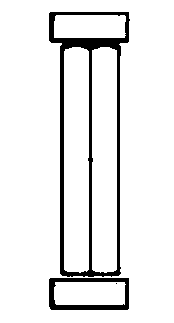Assembly process of cylindrical lithium-ion cell
A lithium-ion battery and assembly process technology, which is applied to secondary batteries, battery pack components, non-aqueous electrolyte batteries, etc., can solve problems such as poor shape of tabs, affect production efficiency, increase defective products, etc., and achieve product performance safety Reliable, the welding surface is clearly visible, and the effect of saving the space in the shell
- Summary
- Abstract
- Description
- Claims
- Application Information
AI Technical Summary
Problems solved by technology
Method used
Image
Examples
Embodiment Construction
[0031] The present invention will be further described in detail below in conjunction with specific embodiments and accompanying drawings.
[0032] Such as Figure 1-Figure 14 As shown, a cylindrical lithium-ion battery assembly process, the process specifically includes the following steps:
[0033] 1. Ultrasonic kneading at both ends of the core: This process uses ultrasonic kneading to slightly shape the two ends of the lithium-ion battery core. Through vibration and extrusion, the two ends are respectively kneaded into the core for 1-3 Depth in mm, see figure 1 . The lugs of the winding core obtained in this way are strong and reliable, and provide a good welding platform for the current collecting plate. On this plane, the winding core is welded to the tabs, which reduces the internal resistance of the battery on the one hand, and improves the Concentration effect. See the roll core after kneading figure 2 , At this time, the short-circuit situation at both ends of ...
PUM
 Login to View More
Login to View More Abstract
Description
Claims
Application Information
 Login to View More
Login to View More - R&D
- Intellectual Property
- Life Sciences
- Materials
- Tech Scout
- Unparalleled Data Quality
- Higher Quality Content
- 60% Fewer Hallucinations
Browse by: Latest US Patents, China's latest patents, Technical Efficacy Thesaurus, Application Domain, Technology Topic, Popular Technical Reports.
© 2025 PatSnap. All rights reserved.Legal|Privacy policy|Modern Slavery Act Transparency Statement|Sitemap|About US| Contact US: help@patsnap.com



